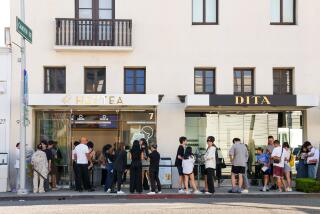Health Trend Spills Into Tea Market
- Share via
At some point in the 2000s, we’ll look back on the Starbucks era and wonder what we were thinking to infuse our bodies with so much jitters-inducing caffeine.
So hope the gurus at Republic of Tea, a quirky Novato producer of full-leaf premium teas that is attempting to turn people on to its more mellow beverages and thus brew a revolution in Americans’ drinking habits.
Adding a new ripple to the fast-growing specialty-tea category--worth $446 million nationwide in 1997 and rising--Republic of Tea has quietly launched the nation’s first line of full-leaf organic teas.
The organic items, selling for $8 to $14 per 3.5-ounce tin in natural food shops and chains, will make their official debut next month at the International Fancy Food and Confection Show in San Francisco.
In development for two years, the certified-organic line is aimed at consumers--or “citizens,” in the company’s special lingo--who are aware of the environmental benefits of growing crops without the use of synthetic pesticides and herbicides. Most of the organic teas--including Garden Green Ceylon and Indian Breakfast Assam--come from the Darjeeling region of India and Sri Lanka.
“The biggest reason we’ve come out with the line is consumer demand [for organic items],” said Julie van Amerongen, Republic of Tea’s minister of marketing and communications. (In keeping with the “republic” theme, the company calls its departments “ministries” and some of its executives “ambassadors.”)
Much has happened in the tea world since Republic of Tea was established in 1992 by Mel and Patricia Ziegler, founders of the Banana Republic clothing chain, and marketing maven Bill Rosenzweig. Back then, van Amerongen said, there were fewer than five other trademarked U.S. tea companies; now there are more than 400. Among them are Water & Leaves and Leaves, both based outside San Francisco; Tazo of Portland, Ore.; and Golden Moon of Seattle. The companies’ stock in trade has been creative blends of herbs and teas.
In 1995, Republic of Tea was bought by Ron Rubin, an Illinois entrepreneur who has worked in the beverage industry since 1972. As sole owner, he declines to reveal sales and profit figures.
Unlike the buzz-driven boom in coffees, the long-predicted revolution in tea, with its lower caffeine component, is taking longer to steep.
“Predictions of large tea chains . . . have failed to materialize,” said Brian Keating, president of Sage Group, a Seattle market research firm that has tracked the tea industry for five years.
But that could change. Although Republic of Tea is focusing on building brand recognition, it does not rule out eventually opening tea shops. And giant Lipton Tea Co., a unit of Unilever, unveiled a prototype Lipton Tea House in Pasadena’s Old Town section in late 1996, offering 52 varieties of loose-leaf tea plus spritzers and frappes. Business there “is really picking up,” said supervisor Andrea Chavez.
For years, van Amerongen said, people have been saying tea is the wine of the ‘90s. “I think this year it might really be true,” she said.
Chips Ahoy
Continuing the rampant consolidation in the organic and natural foods business, Shansby Group, a San Francisco-based investment partnership, has added Los Angeles-based Garden of Eatin’, maker of blue corn tortilla chips, to a stable of four companies that also include Arrowhead Mills, a cereal and grain producer, and DeBoles Nutritional Foods, a maker of natural pastas. The hope is to take the companies public this year.
Martha Groves can be reached by fax at (213) 473 2480 or by e-mail at martha.groves@latimes.com
More to Read
Eat your way across L.A.
Get our weekly Tasting Notes newsletter for reviews, news and more.
You may occasionally receive promotional content from the Los Angeles Times.











